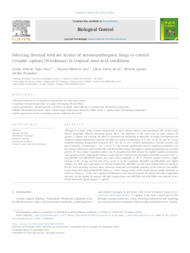Selecting thermal tolerant strains of entomopathogenic fungi to control Ceratitis capitata (Wiedeman) in tropical semi-arid conditions.
Selecting thermal tolerant strains of entomopathogenic fungi to control Ceratitis capitata (Wiedeman) in tropical semi-arid conditions.
Autoria: GAVA, C. A. T.; LEAL, C. M.; SÁ, A. V. de; PARANHOS, B. A. G.
Resumo: Although it is usual, using constant temperature to select thermo-tolerant entomopathogen (EF) strains could discard potentially efficient biocontrol agents (BCA). The objectives of this work were to select virulent EF against C. capitata and evaluate the effect of continual and fluctuating temperature on fungal development and virulence. Initial experiments compared the effect of constant temperatures (CT) (20, 25, 30, 35, and 38 ?C) and simulated intraday temperature variation (SIV) (20?38 ?C) over conidial germination, mycelial growth, and insect mortality. Temperatures ? 35 ?C in the CT experiments significantly reduced conidial germination, and the strains of Beauveria bassiana BbLCB81 and BbLCB289 showed the highest conidial germination and mycelial growth. SIV also caused a significant effect, and M. anisopliae MaLCB62 showed the highest conidial germination and mycelial growth. Applying EF strains as toxic baits in CT showed that the highest mortality occurred at 30 ?C, and BbLCB62 and BbLCB289 showed the largest insect mortality at 38 ?C. Survival analysis showed a slight increase in the average survival time (ST50) at 30 ?C. In SIV conditions, MaLCB56 and BbLCB289 were highly virulent. In a field cage experiment at a warmer temperature, BbLCB62 was the most virulent strain according to the M-C test comparing survival curves. However, confirmed accumulated mortality on the 10th day was similar to the moderately tolerant BbLCB289 (Tukey, p < 0.05). During winter, all EF strains showed similar mortality on 10th day (Tukey, p < 0.05), but a significant difference in the survival analysis. EF strains with mild temperature tolerance can be applied in seasons with high temperatures, and BbLCB62 and BbLCB289 were selected as potential biocontrol agents against C. capitata.
Ano de publicação: 2022
Tipo de publicação: Artigo de periódico
Unidade: Embrapa Semiárido
Observações
1 - Por padrão são exibidas publicações dos últimos 20 anos. Para encontrar publicações mais antigas, configure o filtro ano de publicação, colocando o ano a partir do qual você deseja encontrar publicações. O filtro está na coluna da esquerda na busca acima.
2 - Para ler algumas publicações da Embrapa (apenas as que estão em formato ePub), é necessário ter, no celular ou computador, um desses softwares gratuitos. Sistemas Android: Google Play Livros; IOS: iBooks; Windows e Linux: software Calibre.
Acesse outras publicações
Acesse a Base de Dados da Pesquisa Agropecuária (BDPA) para consultar o acervo completo das bibliotecas da Embrapa.

